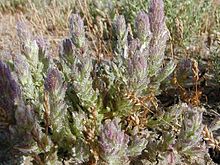- Cordylanthus palmatus
-
Cordylanthus palmatus 
Conservation status Scientific classification Kingdom: Plantae (unranked): Angiosperms (unranked): Eudicots (unranked): Asterids Order: Lamiales Family: Orobanchaceae Genus: Cordylanthus Species: C. palmatus Binomial name Cordylanthus palmatus
A.GrayCordylanthus palmatus is a rare species of flowering plant in the broomrape family known by the common names palmate bird's beak and palmbract bird's beak. It is endemic to the Central Valley of California, where it is known from a few remaining occurrences in the rare alkali sink habitat type. The plant is limited to seasonally-flooded flats with saline and alkaline soils, where it grows with other halophytes such as iodine bush and alkali heath.[1] It is a federally listed endangered species. The main threat to its existence is the destruction of its already naturally limited habitat for agriculture and development, with other adverse effects from alteration in hydrology, off-road vehicles, and grazing of livestock.[1][2] The plant is currently known from 21 locations[3] in seven metapopulations.[1]
This is an annual herb growing 10 to 30 centimeters tall. It is gray-green in color, glandular, and coated with hairs. It is often encrusted with salt crystals it has excreted. The sparse leaves are oblong and sometimes have lobes along the edges. The inflorescence is a dense columnar spike of flowers up to 15 centimeters long. The bracts surrounding the flowers are leaflike and palmate in shape, with several lobes. Each flower is up to 2 centimeters long and has a fuzzy white pouch, sometimes tinted purple, enclosed in darker sepals.
References
External links
Further reading
- Coats, R., et al. (1993). Management plan for an alkali sink and its endangered plant Cordylanthus palmatus. Environmental Management 17:1 115-27.
- Fleishman, E., et al. (2001). Rules and exceptions in conservation genetics: Genetic assessment of the endangered plant Cordylanthus palmatus and its implications for management planning. Biological Conservation 98:1 45-53.
Categories:- Orobanchaceae
- Flora of California
Wikimedia Foundation. 2010.

